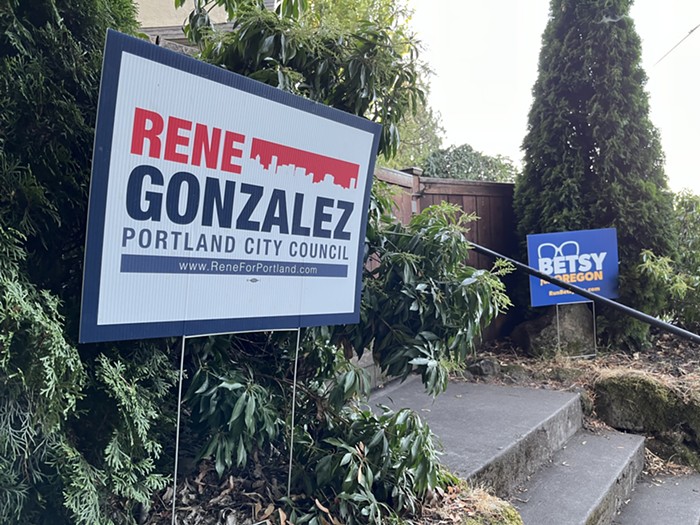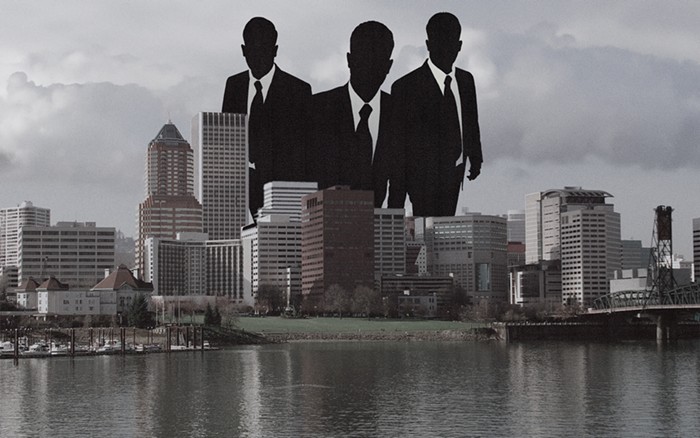IT'S BEEN WEEKS since the "Big One." And Portland is in shambles.
The 9.0 magnitude earthquake has reduced the city's brick and concrete buildings to piles of rubble. Here and there—with their glass skins shattered and dribbling down—steel frames rise from the debris like withered weeds sprouting from cracks in the pavement.
The survivors look for help wherever they can. They would call for help, only they can't.
The city's cell phone towers have toppled to the ground, too top-heavy to withstand the quake's mad rumblings. They're now useless. So are the fiber optics that powered this "wireless" technology as well as the city's internet and digital phone networks. The broken fiber optics are another gloomy and fatal reminder that, in the end, the agencies and utilities that could have done something to keep this total collapse from happening didn't act in time.
The truth is nobody is ready for the Northwest's coming monster quake ["The First Four Minutes," Feature, March 15, 2012]. Yet even though it can be argued nearly everyone involved in earthquake preparedness is dropping the ball in one way or another, experts say one group in particular has stuck its collective head very deep in the sand: Oregon's telecoms.
Earthquake planners say the state's telecoms infrastructure is woefully inadequate to the task of holding up in the 9.0 disaster. The telecoms' networks are vulnerable. Many telecom buildings were built prior to current seismic codes. These act as hubs for internet and digital voice communications and 911 calls. And many could collapse.
Currently planners are recommending telecom buildings be held to the same high seismic standards as emergency facilities like hospitals and fire stations. Only they're having trouble getting traction with this idea. State planners at the Oregon Seismic Safety Policy Advisory Commission (OSSPAC)—the state group tasked with finding out how bad our coming quake will be—say Oregon telecoms, big and small, have failed to answer the call to participate in the planning process.
"There were at least 40 from the telecom industry that were invited to the kick-off meeting—and we had two that showed," says Michael Mumaw, emergency manager at the City of Beaverton and head of the Information and Communications Task Group. Mumaw told the Mercury the overwhelming majority of the emails and phone calls he and others sent out to the telecoms went unanswered.
_________________________________________________________________________________________
Pasturing the COWs: Acronyms, Ad Hoc Networks, Trucks, and Trailers
Navigating the wreckage of fallen cell towers and broken fiber optic lines, the Federal Emergency Management Agency and the telecoms are bringing in the COWs and COLTs. Hauled by truck and positioned amid the ruins, these COWs are Cells on Wheels—camper-sized trailers jam-packed with telecommunication equipment. COLTs, or Cells on Light Trucks, accompany them. Together they form the disjointed backbone of the new ad hoc and temporary telecommunications network.
The COWs and COLTs are here to do what the crippled telecommunications networks can't: send and receive signals. Once in place with antennas aimed at the heavens, they begin transmitting voice and text messages from cell phones, up to satellites, and finally back down to Earth's less chaotic, saner locales. These first calls will be reserved for emergency responders—who, up until now, have relied on ham radio and satellite phones. But others, eventually, including everyday survivors, maybe even you, will make their own first post-disaster calls on this makeshift network, reaching out to the unaffected parts of the world to say, "Don't worry, I'm okay."
This scenario is just one of many we could experience if the Cascadia subduction zone "megathrust" earthquake that Oregon is expected to endure sometime within this century were to hit tomorrow.
It's also, engineers say, a very likely scenario if the state's telecoms don't start upgrading their networks and buildings to weather the coming disaster. Yet just how many preemptive measures the telecoms are willing to undergo is another story.
Following the quake, Oregon is expected to bury up to 10,000 dead. Emergency responders could take two weeks, or longer, to get to those in need, and basic services like water, sewers, electricity, access to fuel, and telephone and internet connections are expected to stop working for months and then be severely limited for years.
Which is precisely why members of OSSPAC are asking the telecoms to step up.
Engineer Devon Lumbard, who seismically sized up Oregon's telecom buildings for OSSPAC, told the Mercury he also reached out to the telecoms, but his messages "were never returned."
Another OSSPAC member, who asked not to be identified, told the same story.
Among those that supposedly didn't respond to OSSPAC were Oregon's two largest telecoms: CenturyLink and Frontier Communications. The telecoms say it was all just a matter of miscommunication.
Frontier spokesman Steven Crosby told the Mercury via email that the person Mumaw says he tried to contact has "no recollection of any contact directly from OSSPAC," but added, "Frontier would gladly participate in any OSSPAC meetings as they occur in the future." CenturyLink spokesman Martin Flynn didn't comment on the miscommunication with OSSPAC, but did promise to "be more proactive."
If those anecdotes about unanswered messages seem inconsequential—or even understandable, given the awkward divide utilities straddle between public good and private enterprise—then consider the industries that did get involved.
According to J.R. Gonzalez, chairman of OSSPAC's energy group, his team had 12 industry participants from companies including Portland General Electric, Northwest Natural, and PacifiCorp. The Bonneville Power Administration sent over two participants. In total, private utilities made up about half of the energy group.
This participation, says Gonzalez, who formerly led the state's seismic regulatory efforts at the Oregon Public Utility Commission, came from goodwill built, in part, on earlier joint efforts between the state and businesses. And this relationship has borne fruit.
_________________________________________________________________________________________
Oregon's Most Critical Six Miles
The uninviting, industry-choked banks of the Willamette River, from the Fremont Bridge to Sauvie Island, arguably makes up the most important six miles in all of Oregon.
It's filled with fuel tanks, docks, pipes, and transmission lines. It holds about 90 percent of the state's liquid petroleum. Northwest Natural's gas pipeline passes through, as do several high-voltage transmission lines. State engineers say much of the infrastructure in this critical "hub" must be retrofitted to withstand the Big One. There's also the nasty problem of liquefaction, or the tendency of seemingly solid ground to jiggle into quicksand during an earthquake. A related phenomenon called "lateral spreading" is also expected to do a number on the infrastructure. But companies in the hub—including household names like BP, Chevron, and Conoco Phillips—know all about this, in part because they've let state regulators poke around their properties and tell them what needs fixing.
The telecoms say they, too, have worked with state regulators on seismic issues. But this work hasn't produced the same level of detailed knowledge. They also point to disaster-relief plans that include "mutual aid" agreements with neighboring companies that, in effect, say they'll put aside their competitive differences and play nice during an emergency. Oregon telecoms are also slowly seismically upgrading their equipment.
But OSSPAC says this isn't enough. The commission members say they want the telecoms to raise their building standards. This suggestion doesn't appear to be that popular.
_________________________________________________________________________________________
Testifying on the Plan
In December 2012, the Oregon Public Utility Commission (OPUC) and some of the state's electric, gas, and telecom utilities met to review a draft of OSSPAC's resiliency plan—including recommendations about buildings.
"Are our plans built for a 9.0 earthquake? No. I can tell you that flat out," CenturyLink's Ron Trullinger told the commission. "But if the goal is to build our networks out to a 9.0 earthquake, there are a lot of questions and a lot of dollars associated with making that happen. Could be in the hundreds of billions of dollars."
This statement follows an earlier one by Trullinger that he hadn't seen the OSSPAC study up until "about a month ago." OSSPAC's Mumaw says Trullinger was one of the people his group reached out to when they started in January 2012.
But other telecom reps do appear to have fallen through the cracks.
Also testifying at the meeting was Brant Wolf from the umbrella group the Oregon Telecommunications Association. Wolf told the state board he hadn't been contacted until November of 2012, just before he was set to review OSSPAC's plan.
Mumaw was able to confirm that this is in fact what happened.
"Our frustration," Wolf told the Mercury, "is we were not given the opportunity to participate... What I don't like is the impression that we weren't interested."
Addressing the fixes to central offices, Trullinger told the commission OSSPAC's recommendation was unclear. But he doesn't dispute the vulnerability claim. That's because Trullinger knows CenturyLink's central offices are its Achilles' heel, and publicly he's said as much.
In a February 2012 OPUC meeting, Trullinger told the commission, "As far as our buildings go, that's probably where we have the most vulnerability."
And he's right.
_________________________________________________________________________________________
CenturyLink's Vulnerable Buildings
One of CenturyLink's most important offices sits inside Portland's most crucial telecommunications hub. Underneath the downtown streets that make up the hub is a spaghettied mess of densely packed fiber and copper cables. Like your body holding in all those feet of intestines, the hub packs a lot into a very small space, just about six square blocks. Making sense of all this chaos are buildings that act as rerouting stations. These are digital "hotels" like the Union Bank Building and the Pittock Block Building. Brand-name telecoms like AT&T and CenturyLink are also feeding off the data-dense lines of fiber and cable.
CenturyLink's hub presence is an imposing concrete edifice used to switch internet traffic, phone calls, and 911 service. The building was built in the late 1960s, and given how other buildings that old have held up, or not, in big quakes, engineers say CenturyLink's building might not fare so well when our subduction zone ruptures. This fact hasn't escaped emergency planners.
In its 2012 Earthquake Response Appendix, the Portland Bureau of Emergency Management (PBEM) highlights the importance of this building, and two other CenturyLink offices, for connecting calls and linking fiber optics. The report then ominously notes they "were constructed prior to seismic building codes."
Flynn, CenturyLink's spokesman, wouldn't comment on what work, if any, had been done to the building. But he didn't have to.
An engineer who worked on the downtown office and asked not to be named, says CenturyLink had done some seismic work that involved securing the building's concrete exterior. But he says no other deeper structural upgrades seem to have been made.
Hoping to learn more about CenturyLink's three Portland offices, the Mercury submitted a public records request asking for emails between PBEM and CenturyLink about the buildings. But, citing security concerns, CenturyLink persuaded the city attorney's office to block it.
Asked about our request, Flynn said, "There's a reason why we don't [release this information]. We are the 911 backbone. We're the emergency communications backbone. It's a safety issue for us for us to release that information."
CenturyLink isn't the only important telecommunications hub that's more concerned with security than seismic preparedness. There's also the Pittock Block Building on SW Washington—a nearly 100-year-old office building that not only holds many important servers for big-name companies, it's also the spot where Portland's internet comes in and branches out to rest of the city.
_________________________________________________________________________________________
Inside Portland's Internet Exchange
My guide and I walk by a security guard stationed behind thick glass. The guard glances up from his closed-circuit monitor and gives me a look. I stop taking notes and try to act normal. My guide places his hand on the biometrics reader. The thick security door unlocks, and we enter the labyrinthine corridors of Pittock's restricted area. Yet, for all these precautions, the Pittock is still extremely vulnerable.
This was three years ago, when I took an impromptu tour of Portland's arguably most critical telecommunications hotspot. What's housed there are some of the city's best worst-kept secrets. And as I follow my guide through a series of sterile halls, I pass many of Portland's most important servers locked inside black cages. Here are just a few: City of Portland servers, servers for a security company that dials 911 when your house is broken into, and servers for Verizon, Yahoo, and EarthLink. And then there's the fiber.
Running in and out of the Pittock are fiber optics from 17 providers including important telecoms like AT&T, Verizon, and CenturyLink. Wrapped in bundles, this fiber courses in from all directions from Portland's underground into the building's basement and past the cavernous voids that once housed the old building's massive boilers.
From there it travels upward to server rooms like the one I am standing in. The whole process then reverses, and more lines head down and then out of the building in all directions. Trace this tangled maze of comings and goings far enough and you'll find these fiber optics bundles extend all the way around the world. This is Portland's most palpable connection to the internet's nervous system. It's the crossroads of the city's fiber optics network, and it's housed in a building that was built in 1914.
It's unclear if the Pittock has had any seismic retrofitting done to it. Tom Bechtell, who manages the building for Alco Properties, didn't return the Mercury's phone calls.
As for OSSPAC, Mumaw says the Pittock was on his group's radar, but they didn't reach out to its managers.
What is clear, say engineers and emergency planners, is our data-hungry culture is getting hooked on fiber and for that reason places like the Pittock will become more and more important.
_________________________________________________________________________________________
The Road Ahead, a Step Behind
Telecommunications are now phasing out analog signals that travel on copper lines for digital ones that travel on fiber optics.
When the transformation is finally complete—as digital voice subscribers today know—the good old days when the power went out and your phone still worked will be long gone. In the future, you'll need electricity in your home just to use your landline.
Considering a subduction zone quake will cripple the electric grid and deliver a severe body blow to cell service, that isn't exactly good news—but then again, none of it is.
And, of course, this scenario—with its crippled fiber lines, crumbled buildings, and toppled towers that could severely curtail communication for up to three years—is just one of many possibilities. But it's a possibility Portland needs to prepare for, because when the Big One hits, communication isn't just a convenience. It's a lifeline.













